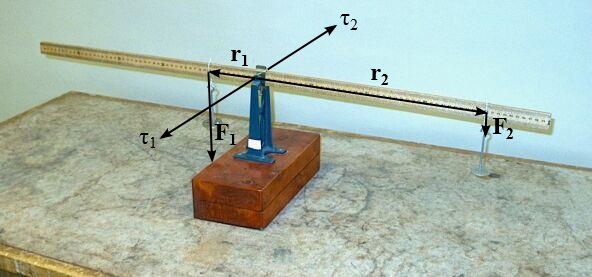

The meter stick in the photograph above is mounted on a knife-edge pivot placed at its center. Each mass hanger, with whatever masses are on it, exerts a torque about the pivot, which is τ = r × F, where r is the displacement vector from the pivot to the point from where the mass hanger is suspended, and F is the applied force, which is the weight of the hanger and masses, mg. Thus, by the right-hand rule, a torque exerted by a hanger suspended from the right side of the meter stick points inward (toward the back of the table in the photograph) from the pivot point, and one applied by a hanger suspended on the left side of the stick points outward from the pivot point. The magnitude of this torque is rmg sin θ, where θ is the angle between r and F. For the mass hangers, when the meter stick is horizontal, θ equals 90 degrees, sin θ equals 1, and τ = rmg. Torque, especially in this context, is often called the moment of force, and r is the moment arm. If the meter stick were not horizontal, then the moment arm for each mass hanger would be r sin θ, the perpendicular distance from the pivot to the point from which the mass hanger is suspended.What this has to do with equilibrium:
As noted above, each mass hanger exerts a torque that is opposite to that produced by the other. For the meter stick to balance, the moments must equal. That is, r1m1g = r2m2g, or r1m1 = r2m2. So for the meter stick in the photograph, since the moment arm of the mass hanger on the right (~0.4 m) is four times that of the one on the left (~0.1 m), the total mass on the left must be four times that on the right for the meter stick to balance as shown. When it does, the lever arm is said to be in equilibrium. If we add or remove mass on one side, or slide the mass hanger to a different position, the torques are then not equal, the lever arm is thus no longer in equilibrium, and it turns in the direction of the greater torque. This is the principle behind an analytical balance, in which one places an unknown mass on one side of the balance, and adds known masses to the other side until the two torques cancel.
There is a subtle detail in the way this lever arm is constructed, which is that the pivot is slightly above the center line of the meter stick. If it were at the center line, then if the torques on both sides were equal, the lever arm could sit at any angle; it would be in neutral equilibrium. (See demonstration 32.20 -- Neutral, stable and unstable equilibrium.) Because the pivot is above the center line of the meter stick, however, tilting the lever arm to either side raises the center of mass of the system slightly and thus raises the potential energy of the system. To lower its potential energy, the lever arm rotates back to where it is level. It is in stable equilibrium.
The meter stick as set up in this demonstration represents a class one lever. This is a lever for which the “load” and the “effort” are on opposite sides of the fulcrum. If the load is closer to the fulcrum than the effort, the lever is said to afford a mechanical advantage of the ratio of the moment arms, reffort/rload. For the meter stick in the photograph, if we consider the weight on the left to be the load, and take the weight on the right as the effort, the ratio of their moment arms is 40 cm/10 cm, which gives a mechanical advantage of 4:1, so as noted above, the effort must be 1/4 the load to balance.
References:
1) Resnick, Robert and Halliday, David. Physics, Part One, Third Edition (New York: John Wiley and Sons, 1977), pp. 231-3, 291-3.